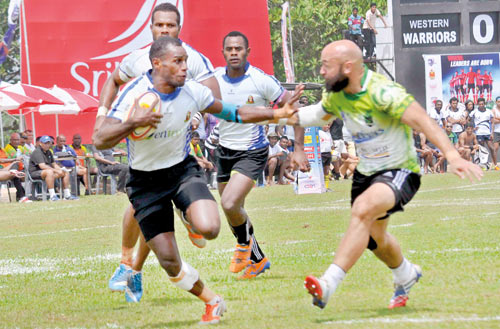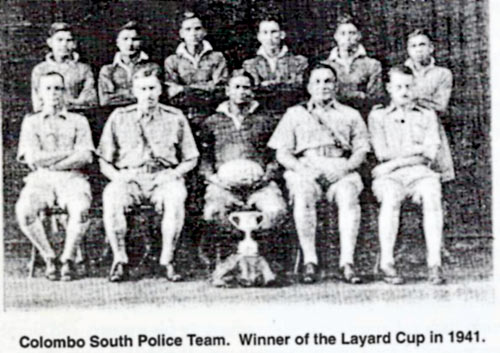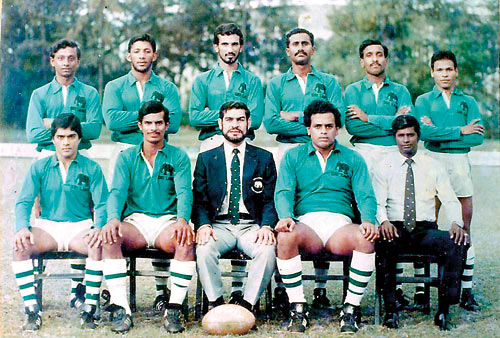Seven-a-side Rugby: A leaf from our history
 Another major event will be added to the island’s Rugby history with the ‘kick off’ of the “Super 7s” tournament scheduled for the first weekend in August. The first ever ’7-a-side’ Rugby match in Ceylon (as Sri Lanka was then known) was played in 1931 at Ratnapura. The man who introduced this shorter version of William Webb Ellis’ game to the island was a Welshman named K.F. Jenkins. In 1931, Jenkins was stationed at Ratnapura as a Probationary Assistant Superintendent of Police. Being a Rugby enthusiast, he arranged a 7-a-side match between the local Police team and the Planters of the area on February 1, 1931, at the Ratnapura esplanade.
Another major event will be added to the island’s Rugby history with the ‘kick off’ of the “Super 7s” tournament scheduled for the first weekend in August. The first ever ’7-a-side’ Rugby match in Ceylon (as Sri Lanka was then known) was played in 1931 at Ratnapura. The man who introduced this shorter version of William Webb Ellis’ game to the island was a Welshman named K.F. Jenkins. In 1931, Jenkins was stationed at Ratnapura as a Probationary Assistant Superintendent of Police. Being a Rugby enthusiast, he arranged a 7-a-side match between the local Police team and the Planters of the area on February 1, 1931, at the Ratnapura esplanade.
Play commenced as early as 7 am, leaving sufficient time for the players to enjoy the Sabbath day. There were players of all sorts. Players who had played Rugby before, players who had witnessed the game but, not actively participated, and there were others who had never touched a Rugby ball before. Anyhow, it marked the beginning of 7-a-side Rugby in the country. By then, 52 years had passed since the introduction of Rugby to the island. The earliest record of the game’s presence on Sri Lankan soil goes back to 1879, when two teams, the Colombo Football Club and the World XV (Rest team) figured in, what was then called the first ever 15-a-side Rugby match played on local turf.
 The players were Europeans drawn from the Services, Mercantile and Planting sectors. It was the beginning. Thereafter, the game had to pass a turbulent phase but amazingly, it survived. The opposition comprised a section of the very same expatriate circle which introduced the game to the island. They viewed Rugby as a dreadful game. Here is a striking example: “The Times of Ceylon” which had an all-European editorial at the time, stated in one of its editions published in 1884 that, “If the barbarous, brutish, knocking and kicking and hitting and pushing and pulling each other, called Rugby ranks amongst athletic sports of the 19th century, we are sure that our progress is backwards”.
The players were Europeans drawn from the Services, Mercantile and Planting sectors. It was the beginning. Thereafter, the game had to pass a turbulent phase but amazingly, it survived. The opposition comprised a section of the very same expatriate circle which introduced the game to the island. They viewed Rugby as a dreadful game. Here is a striking example: “The Times of Ceylon” which had an all-European editorial at the time, stated in one of its editions published in 1884 that, “If the barbarous, brutish, knocking and kicking and hitting and pushing and pulling each other, called Rugby ranks amongst athletic sports of the 19th century, we are sure that our progress is backwards”.
Yet the game progressed in the British Colony, with its own characteristic identity, on rock-hard local playing fields with bamboo or arecanut tree trunk goalposts. On September 12, 1907 the All-Ceylon team figured in their first ever Rugby international, confronting the New Zealand ‘All Blacks’ at the Havelock Racecourse. Led by Hercules Wright, the New Zealanders, as it was reported, “gave the local folk an insight into some finer points of Rugby.” The result: All Blacks 33 – All Ceylon 06. On August 10, 1908, the governing body of the sport- Ceylon Rugby Football Union, was formed with upcountry planter H.B.T. Boucher as its first President.
In 1909, an all-European ‘All-Ceylon’ team toured Madras to take part in the Madras Presidency tourney, and it turned out to be the maiden overseas tour by a Rugby team from Sri Lanka. 1911 saw the inauguration of the Clifford Cup Rugby tournament. Arguably, the Clifford Cup holds a supreme spot in Asian Rugby, as one of the oldest Rugby tournaments in the region. Under the captaincy of former South African player J.D. Farquharson, the All-Ceylon team emerged champs at the All-India Rugby tourney for the first time in 1929. When an All-Ceylon team played against the visiting British Lions XV at the Colombo Racecourse in 1930, P.A. Buultjens of Trinity College, Kandy SC and CR&FC fame, was a reserve for the All-Ceylon team comprising wholly of Europeans.

The New Zealand All Blacks and All Ceylon teams in 1907 after their match in Colombo. All Blacks won 33-6
Against a backdrop of such achievement behind the game, the first ever 7-a-side Rugby match was played in Sri Lanka in 1931. Arguably, the pioneer tourney in Sri Lanka of this shorter version of William Webb Ellis’ game is the Layard Cup competition organised by the Police Dept. Inaugurated in 1941, this tourney was considered an internal inter-Division competition for the law enforcement officers. Commenting on this new game and the inaugural Layard Cup tourney, “The Times of Ceylon” in its July 6, 1941 issue stated: “Although the duration of a match is only 8 minutes each way with a minute interval, it is played on a full size ground and is exceedingly strenuous”.
It added “7-a-side Rugby is seldom played in Ceylon, but those who were present to witness the closing stages of the Police competition for the Layard Cup, which was won by Colombo South, and the inter-club contest in which the CR&FC scored a great victory on the Havelock Racecourse yesterday afternoon, were treated to an exhibition which will long be remembered. There was a large gathering present including HE the Governor and the 6 matches played were full of interest”. Since 1941, this tourney was continuously conducted by the Police Dept as a pre-season ‘talent search’ competition.

Hong Kong 7s Bowl champions in 1984: Front from left: C.P.P. Abeysunawardene, Hisham Abdeen (Capt), N.H. Omar (SLRFU President), Saman Jayasinghe, Jeff Ratnam Back from left: Len de Silva, Chandrishan Perera, Chula Dharmadasa, Nalin de Silva, Rohantha Peiris, Hubert Rayen
To mark its 25th anniversary, CR&FC, one of the foremost Rugby clubs in Sri Lanka, organised a 7s tournament in 1948 as part of its jubilee celebrations. “The Times of Ceylon – Sunday Illustrated” broadsheet on its October 10, 1948 issue said, “The CR & FC celebrated their 25th anniversary by winning the 7-a-side Rugby tournament yesterday, beating their old time rivals the CH&FC in the final by 10 points to 5. Mrs Weinman gave away the prize to the winning team – a beer mug to each, which they did not take long to fill, empty and fill again”. In the formative years, 7s Rugby tournament was referred to as the “little tourney”. In “Today’s Sports Diary” column in the “Ceylon Daily News” – October 7, 1949 issue, it was stated “Rugby: 7-a-side little tourney – Longden Place at 3.45 pm”.
Sri Lanka’s maiden participation in a major ’7s’ tournament was witnessed in 1956 during the All-India tournament held in Calcutta. And they won the “B.I. Centenary All-India 7s trophy” donated by the British India Steam Navigation Company, by defeating the Armenians 13-0. The 1960 All-India 7s final was between Ceylon ‘A’ (Neville Leefe, E.L. Pereira, J. Jackson, M. de Alwis, Nimal Maralande, C. Ephramus and D. Ingleton) and Ceylon ‘B’ (M. Anghie, Peter Sawdy, Ken de Joedt, M. Wright, F. Jacob and C. Woosman-Mills). Ceylon ‘B’ emerged victorious 15-10 at the Island grounds, Madras, to bring back the coveted trophy back to Sri Lanka again.
The Sri Lanka Rugby Football Union (SLRFU) had its first ever inter-club 7s competition in 1976, but no trophy was awarded to the winner!
Although the participation was limited, (Services teams and outstation clubs opted not to take part), the controlling body was overwhelmed with the success of the inaugural tourney. Realising that 7s Rugby is a crowd puller, the SLRFU organised a much better tournament in the following year, with a wider participation. And also offered a Trophy for the winners! The donor of the “7s Trophy” remained anonymous. The SLRFU said it was donated by a well-wisher. Anyhow, there is an interesting story behind the blue riband of 7s Rugby.
When Sri Lanka took part in the first ever Hong Kong 7s tournament on March 28, 1976, under the Captaincy of Indrajit Coomaraswamy, with the late Kavan Rambukwelle as Manager, they were beaten by Singapore and Japan in the main competition and placed in the Plate competition in this single day tourney. The Sri Lanka ’7s’ team had, Indrajit Coomarasamy (Capt.- CR&FC), Lanil Tennekoon and the late Jeffrey de Jong (Havelocks), Mohan Balasuriya and Ronald Rodrigo (Air Force), Maiya Gunasekera (University of Colombo), G. Gunadasa (Army) and Shaan Ching (CH&FC). It was reported that M. Omerdeen (Air Force) replaced Ching at the last minute.
The quarter-final match in the Plate competition was against Indonesia, represented by Djakarta RFC, when Sri Lanka registered their first ever success in the tournament, with a 14-0 victory. Not only the Sri Lankan players, officials and a few supporters who were there at the Hong Kong FC stadium, were delighted with this victory over Indonesia, but the manager of the Indonesian team, Brian Rostill-Huntley, a Canadian living in Indonesia, was also similarly elated. He went over to the Sri Lanka team manager and intimated his willingness to any assistance. As there was no trophy for the domestic inter-club 7s, the late Kavan Rambukwelle, who was also SLRFU Presiden, mooted the idea of being a sponsor for the tournament.
Having considered the request, Djakarta team manager Brian Rostill-Huntley agreed to donate a trophy for the local 7s but, on one condition, “I will donate the trophy but, no name please”. And from the following year- 1977, the local inter-club 7s tournament was played for a trophy donated by the manager of the Indonesian team and called the “SLRFU 7s Trophy”. The 1977 tourney was a one-day affair with Havelocks, CR, CH, Navy, Kandy, Army, Air Force and the Rugby Football Club taking part. The SLRFU also organised a band competition for the girls’ schools during the competition. Whilst CR&FC ‘A’ won the SLRFU 7s trophy, Ananda Balika Girls School won the trophy awarded by the SLRFU for the Girls School Band competition.
Club champs CR ‘A’ had Indrajit Coomaraswamy (Capt.), Jagath Fernando, Dr Maiya Gunasekera, Michael Muller, Andrew Van Hoff, Iqbal Musafer and T. Rudra in their ranks. They defeated Havies ‘B’ 37-0 in the semis and Havies ‘A’ 13-0 in the final, which was refereed by Mohan Sahayam. Sri Lanka’s first ever major triumph in 7s Rugby was in 1984 at the Hong Kong 7s tournament. It was just 9 years since the first kick-off of this tournament and the first year of the ‘Bowl’ competition. Eventually, Sri Lanka became the first winner of the Hong Kong 7s Bowl competition, which was a remarkable achievement in the annals of Sri Lanka’s Rugby history. The Sri Lanka squad: Hisham Abdeen (Capt.), Nalin de Silva, Saman Jayasinghe, Chula Dharmadasa, Hubert Rayen, Len Silva, Rohantha Peiris, C.P.P. Abeygunawardene and Chandrishan Perera.
Manager cum Coach was Jeff Ratnam. Recalling this famous victory, Kevin Sinclair, a reputed Hong Kong based journalist, in his famous book titled “Hong Kong 7s”, which was published to “Celebrate 10 Glorious Years of Rugby 7s in Hong Kong”, stated: “The Bowl was won, deservedly, everyone felt, by Sri Lanka, a team that had been dutifully coming to Hong Kong every year, doing their best, being tackled by enormous Australians and Canadians, being outrun by speedy Fijians, dazzled by relentless Tongans, but always trying, trying, trying – - – but never winning. They got a big hand when they collected the Bowl, and the new format was also roundly cheered for making the tournament fairer.”


